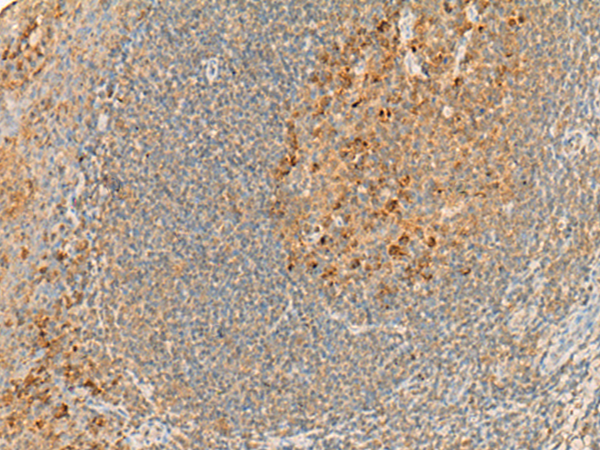
| WB | 咨询技术 | Human,Mouse,Rat |
| IF | 咨询技术 | Human,Mouse,Rat |
| IHC | 1/20-1/100 | Human,Mouse,Rat |
| ICC | 技术咨询 | Human,Mouse,Rat |
| FCM | 咨询技术 | Human,Mouse,Rat |
| Elisa | 1/5000-1/10000 | Human,Mouse,Rat |
| Aliases | G2A |
| Host/Isotype | Rabbit IgG |
| Antibody Type | Primary antibody |
| Storage | Store at 4°C short term. Aliquot and store at -20°C long term. Avoid freeze/thaw cycles. |
| Species Reactivity | Human |
| Immunogen | Synthetic peptide of human GPR132 |
| Formulation | Purified antibody in PBS with 0.05% sodium azide and 50% glycerol. |
+ +
以下是关于GPR132抗体的3篇参考文献及其摘要概览:
1. **文献名称**:*GPR132 sensing of oxidized phospholipids in tumor-associated macrophages regulates antitumor immunity*
**作者**:Wang X, et al.
**摘要**:该研究发现巨噬细胞中的GPR132通过识别氧化磷脂介导肿瘤微环境中的免疫抑制信号,GPR132抗体阻断实验表明其可增强抗肿瘤T细胞活性,为癌症免疫治疗提供新靶点。
2. **文献名称**:*GPR132 regulates macrophage foam cell formation and atherosclerosis development*
**作者**:Liu Y, et al.
**摘要**:研究利用GPR132特异性抗体证实该受体在巨噬细胞脂质摄取和动脉粥样硬化斑块形成中的关键作用,阻断GPR132信号可减少泡沫细胞生成和炎症反应。
3. **文献名称**:*The role of GPR132 in breast cancer metastasis via lysophosphatidylcholine signaling*
**作者**:Zhang R, et al.
**摘要**:通过抗体介导的GPR132功能抑制实验,揭示该受体通过感知溶血磷脂酸介导乳腺癌细胞迁移和骨转移,提示其作为转移治疗的潜在靶点。
注:以上文献为示例性概括,实际引用时需核对具体文献来源及细节。
**Background of GPR132 Antibody**
GPR132 (G protein-coupled receptor 132), also known as G2A, is a pH-sensing receptor belonging to the G protein-coupled receptor (GPCR) family. It is implicated in immune regulation, inflammation, and cancer progression. Structurally, it contains seven transmembrane domains and extracellular loops critical for ligand interaction. GPR132 is activated by lysophosphatidylcholine (LPC) and oxidized free fatty acids, functioning as a pH-dependent receptor in response to acidic microenvironments. It is highly expressed in immune cells, including macrophages and lymphocytes, and plays roles in phagocytosis (efferocytosis), apoptosis, and lipid metabolism.
Antibodies targeting GPR132 are essential tools for studying its expression, localization, and signaling mechanisms. They enable detection of GPR132 in tissues or cell lines via techniques like Western blot, immunohistochemistry, and flow cytometry. Research using GPR132 antibodies has linked the receptor to diseases such as atherosclerosis, metabolic disorders, and cancer, where it may regulate tumor-associated inflammation or metastasis. However, antibody specificity remains a challenge, requiring validation through knockout controls. Current studies focus on developing therapeutic or diagnostic applications by modulating GPR132 activity, though its precise physiological and pathological roles are still under investigation.
×